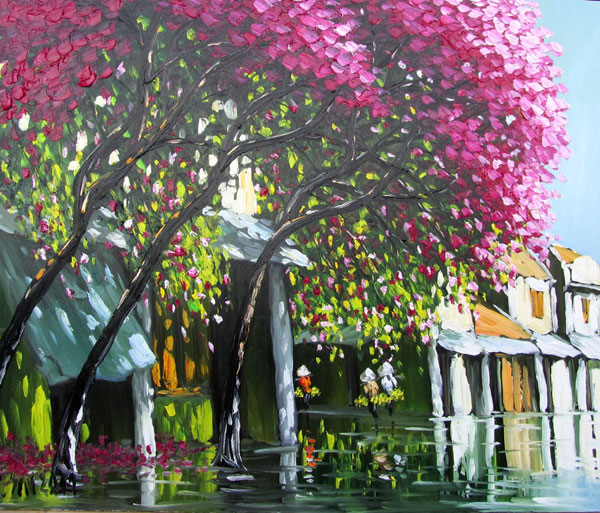By Trieu Khac Tien M.A, Lecturer of Painting Department
As soon as DOI MOI (Renovation) – a program of national renewal involving opening up the country to the outside world and embracing the concept of a market economy – was carried out in Vietnam in 1986. Dramatic changes in Vietnamese social life in general, in Vietnamese culture and arts in particular got apparently recognizable.
Waiting – Le Huy Tiep Artist – 1996
Arts is said to both depend on and reflect society circumstance. Unlike previous periods, which was normally dominated by a mainstream movement ( like romanticism derived from the French between 1925 and 1945, and later socialist realism influenced by the Soviet Union prior to the 90s. ). in the time of mass media and technology nowadays, a variety of contemporary arts movements and tendencies have integrated in Vietnamese cultural activities ( mainly supported by foreign Cultural exchange Funds in Vietnam ) that enables artists ( especially young ones ) to have chance of challenging their avant-garde ideas through various art experiments in the realm of creation.
This advantage paved the way for Vietnamese Arts to join in regional Asian arts communities, exemplified by ASEAN Philip Morris Arts Competitions, or annual exchange Arts events and education among Vietnam and Japan, China, Thailand, Singapore, Malaysia and many others. These interactions have been regarded as a very important development of Vietnamese Arts in approaching globalization.
Nguyen Thanh Binh artist
Nevertheless, new context creates new problems. In a way, Vietnamese artists, in process of art creation, used to function themselves to find out new values of the Beauty beyond classic criteria. Personal character, individual points of views are highly anticipated. Breakthrough and innovative creations resulting in new aesthetic concepts are highlighted. The best and easiest solution for this seems to be looking at regional and international cultural heritage for reference. On the other way, this process may also lead to a copy of other oversea cultural character unless artists are so self-confident to possess a profound professional background and cultural experiences. That is a short-coming problem of Vietnamese Arts today, where a professional art market is still immature, where Chinese Pop Art and Western Expressionism patterned replicas can be seen at any art galleries. In the time of globalization, one of the most important issues is how to preserve and promote national ethnic identities. It is also said that being deeply rooted in traditional art treasure of forefathers is extremely essential to any artist while stepping on his own way towards new horizons of visual creations.
[image src=”https://www.hanoiarttours.com/wp-content/uploads/2016/06/Le-Thanh-Son.jpg” width=”600″ height=”513″]Hanoi Street – Le Thanh Son Artist
Vietnam University of Fine Arts has so far always been the leading art center that identifies the long-term strategy of a holistic education by creating a realm of creative experiment to students. Focusing on the importance of advanced ‘learner – centered methodology”. VNUFA ‘s training program emphasizes creative innovation of learners based on two backgrounds: a well – educated and stable background of western academic knowledge and a precious background of national cultural identity’s experiences. Through cooperation and exchange with regional and international art institutions, VNUFA’s teaching staff and students have been aware that developing a progressive Vietnamese culture imbued with national identity is exactly the key open to the world.
[image src=”https://www.hanoiarttours.com/wp-content/uploads/2016/06/Vietnamese-Artist2.jpg” width=”589″ height=”600″]Bui Huu Hung Artist
In conclusion, prolific cross-national collaboration that generates new cultures is obviously an inevitable tendency of arts development in the time of globalization. How ever, the matter of how to preserve and promote national original identity may vary depending on multiple conditions of each nation. The coexistence of internationalization and national identity preservation has actually diversified new forms of arts development in Asia nowadays..



